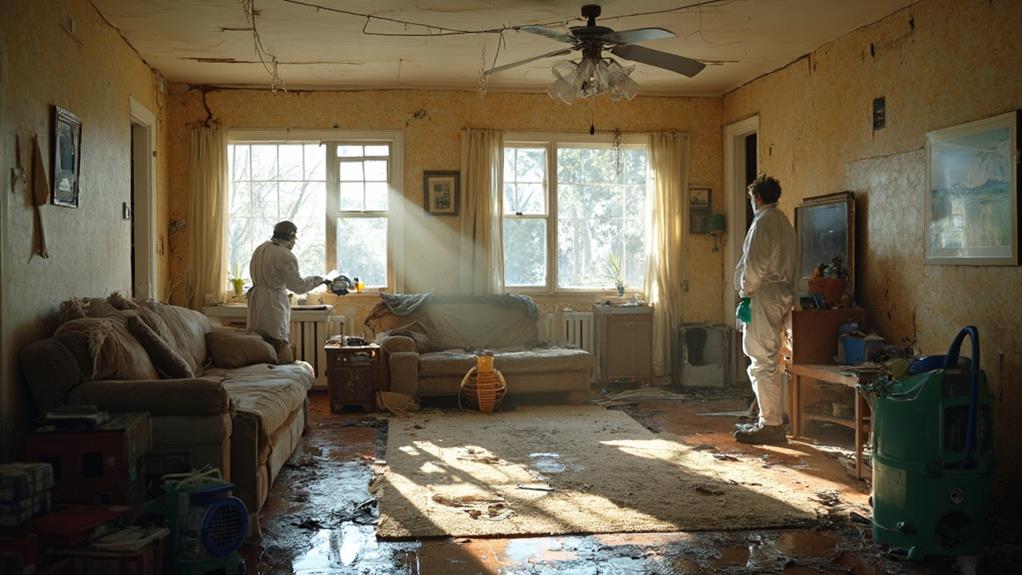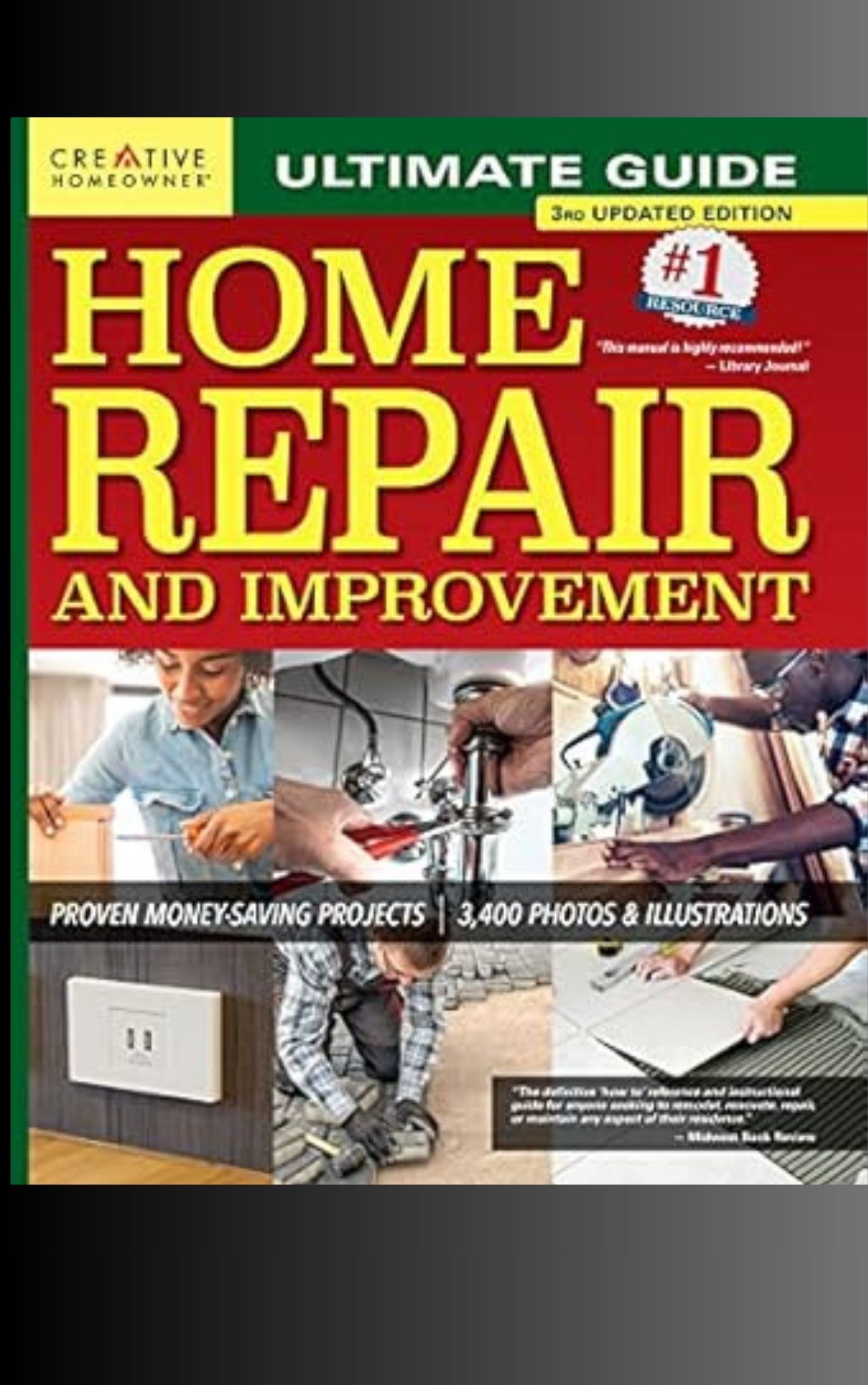Proper techniques for drying out a flooded home begin with safety precautions. Turn off power and inspect for hazards before entering. Remove standing water using pumps or wet vacuums. Clear out wet items and materials, including furniture and damaged drywall. Thoroughly document the damage for insurance purposes. Deploy commercial-grade dehumidifiers and fans to accelerate drying, maintaining humidity levels between 30-50%. Clean and disinfect all surfaces with a bleach solution. Proper ventilation is crucial throughout the process. Remember to wear protective gear and dispose of contaminated items safely. Following these steps diligently can help minimize long-term damage and health risks.
Safety First
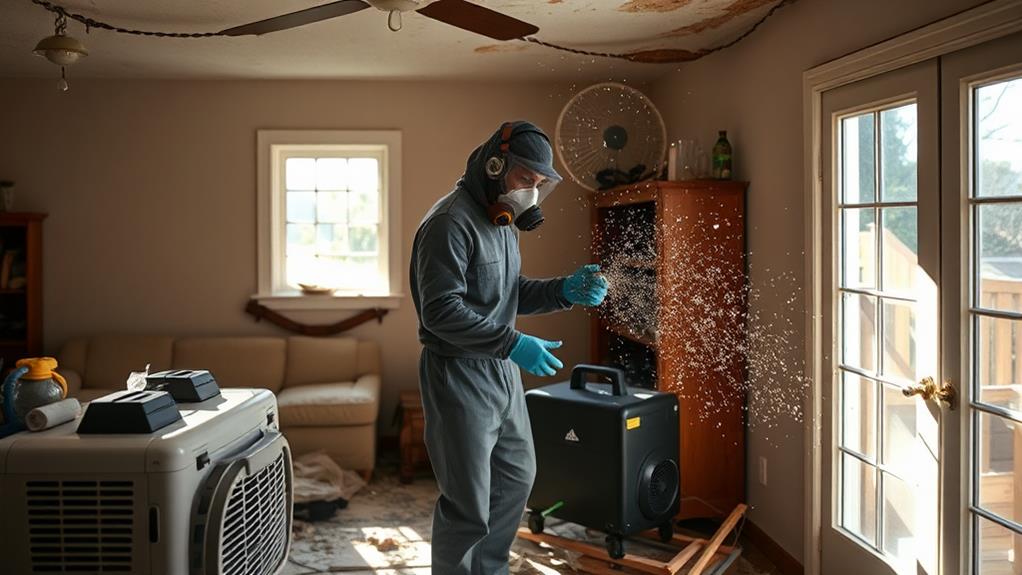
Before entering a flooded home, safety must be the top priority. Ensure the structure is stable and free from electrical hazards. Turn off the main power supply if it's safe to do so; otherwise, contact an electrician. Wear protective gear, including waterproof boots, gloves, and a respirator to guard against contaminants and mold spores.
Inspect for gas leaks, which can be identified by a distinct odor or hissing sound. If detected, leave immediately and contact the gas company. Be aware of potential wildlife that may have sought refuge in your home, such as snakes or rodents. Use a flashlight when entering dark areas, and avoid using open flames for illumination.
Document the damage with photographs for insurance purposes before beginning the cleanup process. Remove standing water using pumps or wet vacuums, but be cautious of electrical equipment near water. Open windows and doors to improve air circulation, which aids in drying and reduces mold growth. Remove wet materials, such as carpets and drywall, to prevent further damage and mold proliferation. Disinfect all surfaces with a bleach solution to kill bacteria and inhibit mold growth.
Remove Standing Water
The first sentence in the "Remove Standing Water" section is: After ensuring safety, the next critical step in drying out your flooded home is to remove all standing water as quickly as possible.
This process is crucial to minimize further damage and prevent mold growth. Use pumps or wet vacuums to extract water from floors, carpets, and other surfaces. For smaller amounts of water, mops and towels may suffice.
If electricity is available and safe to use, deploy fans and dehumidifiers to accelerate the drying process.
Pay special attention to hidden areas where water may accumulate, such as basements, crawl spaces, and behind walls. These spaces can harbor moisture long after visible water has been removed. Consider renting specialized equipment like industrial-grade dehumidifiers or high-powered fans for more efficient water removal and drying.
As you remove water, be mindful of potential contaminants. Floodwater often contains sewage, chemicals, and other hazardous materials. Wear appropriate protective gear, including waterproof boots, gloves, and masks. Dispose of contaminated items properly and disinfect surfaces thoroughly after water removal to ensure a safe living environment.
Clear Out Affected Areas
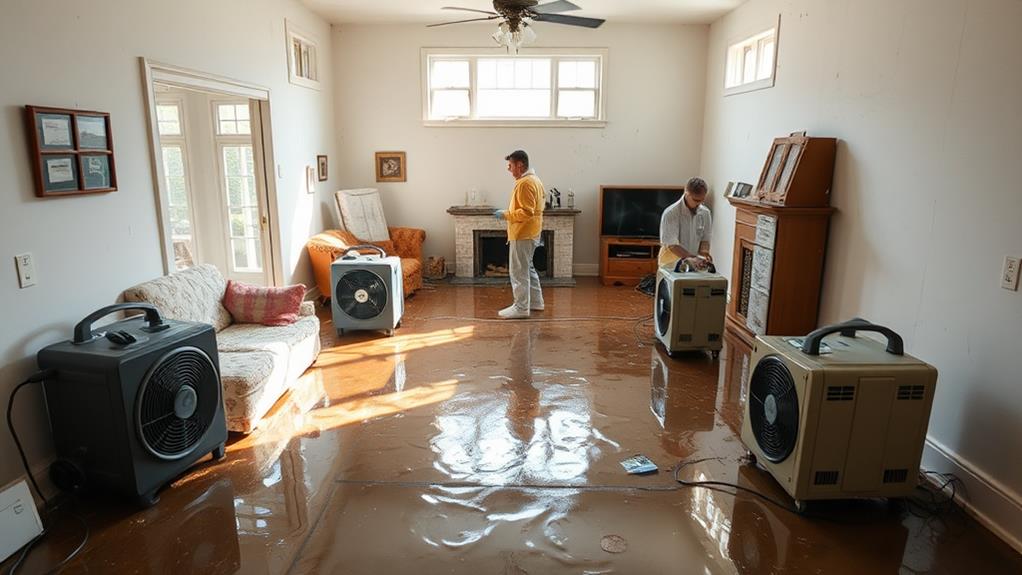
Once standing water has been removed, clearing out affected areas becomes the next crucial step. Begin by removing all wet items, including furniture, carpets, and personal belongings. These items should be taken outside to dry or be discarded if severely damaged.
Pay special attention to porous materials like drywall, insulation, and wooden structures, as they can harbor mold and bacteria.
Remove wet drywall and insulation up to at least 12 inches above the water line. Inspect wooden studs and floor joists for signs of water damage or warping. Clean and disinfect all surfaces that came into contact with floodwater using a mixture of water and bleach or a commercial disinfectant.
Open all windows and doors to promote air circulation. If possible, use fans and dehumidifiers to speed up the drying process. Be cautious when handling electrical appliances or outlets that may have been submerged. Consider hiring professionals for electrical inspections and repairs.
Document all damage and removed items for insurance purposes. Take photographs and keep detailed records of your cleaning and restoration efforts. This documentation will be crucial when filing insurance claims or seeking assistance from disaster relief organizations.
Assess and Document Damage
Assessing and documenting your home's flood damage is a critical step in the recovery process. Begin by thoroughly inspecting all affected areas, including floors, walls, ceilings, and personal belongings. Take detailed notes describing the extent of water damage, listing affected items, and noting any signs of mold growth.
Photograph or video record all damaged areas and items to provide visual evidence for insurance claims and restoration efforts. Capture close-up shots of specific damage as well as wider views to show the overall impact. Document serial numbers of damaged appliances and electronics.
Contact your insurance company promptly to report the damage and initiate the claims process. They may send an adjuster to assess the situation, so maintain accurate records of all communications. Create an inventory of damaged items, including estimated values and dates of purchase when possible.
Consult with professional restoration experts to evaluate structural damage and potential safety hazards. They can provide valuable insights into the extent of the damage and necessary repairs. Keep all receipts for emergency repairs, temporary housing, and other flood-related expenses for potential reimbursement.
Dehumidify and Ventilate
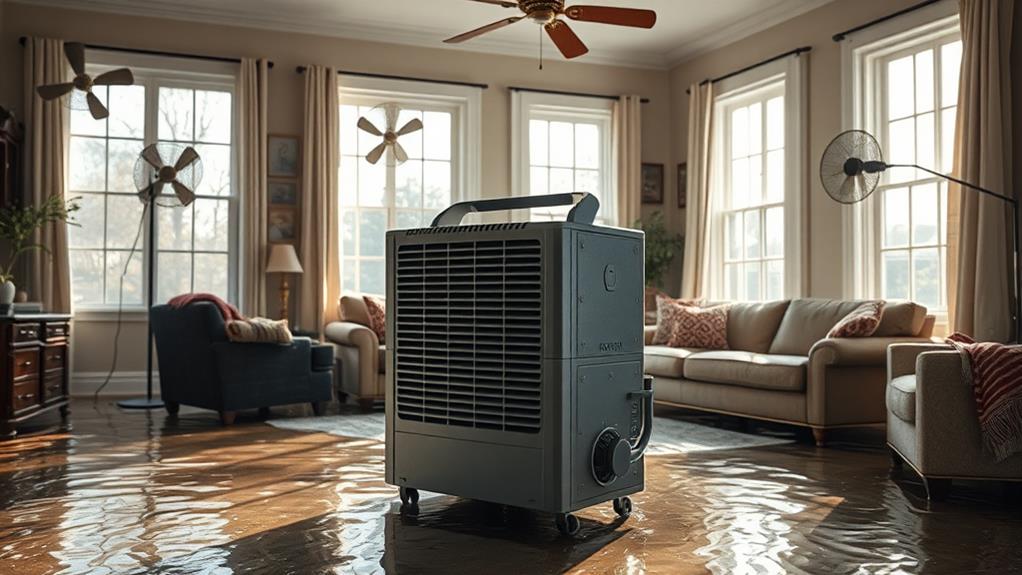
Effective moisture removal is crucial for preventing further damage and mold growth in your flood-affected home. To achieve this, employ a combination of dehumidification and ventilation techniques.
Use commercial-grade dehumidifiers to extract excess moisture from the air, placing them strategically throughout the affected areas. Set the dehumidifiers to maintain relative humidity levels between 30% and 50%.
Enhance air circulation by opening windows and doors when weather permits. Use high-powered fans to promote airflow and expedite the drying process. Position fans to create cross-ventilation, directing air towards open windows or doors. For enclosed spaces, consider using specialized drying equipment such as air movers or ducted air distribution systems.
Monitor humidity levels regularly using a hygrometer, adjusting your approach as needed. Pay special attention to hidden areas prone to moisture retention, such as wall cavities and crawl spaces. If necessary, remove baseboards and drill small holes in walls to allow air circulation within these concealed spaces. Continue the drying process until all affected materials reach their normal moisture content levels, which may take several days to weeks depending on the extent of water damage.
Clean and Disinfect Thoroughly
Sanitizing your flood-affected home is a critical step in the recovery process. Begin by removing all contaminated materials, including carpets, drywall, and insulation. Thoroughly clean all surfaces with a detergent solution, paying special attention to areas where mold may have developed. Scrub hard surfaces with a stiff brush and rinse with clean water.
Disinfect all cleaned surfaces using a mixture of one cup of bleach per gallon of water. Allow the solution to remain on surfaces for at least 10 minutes before rinsing. For porous materials that cannot be discarded, such as wooden furniture, use a specialized cleaner designed for flood-damaged items.
Don't forget to clean and disinfect HVAC systems, as they can harbor mold and bacteria. Replace all air filters and have ductwork professionally cleaned. Wash all salvageable clothing, bedding, and curtains in hot water with detergent and disinfectant.
Wear proper protective equipment during the cleaning process, including gloves, goggles, and a respirator mask. Ensure adequate ventilation by opening windows and using fans. Dispose of all contaminated cleaning materials properly to prevent further spread of pollutants.
Frequently Asked Questions
How Long Does It Typically Take for a Flooded Home to Dry Completely?
The drying time for a flooded home varies depending on factors such as water volume, humidity, and ventilation. Generally, it takes 3-5 days for minor flooding and up to several weeks for severe cases with professional assistance.
Can I Use Fans From My Home, or Do I Need Specialized Equipment?
While household fans can help, specialized equipment like industrial-grade air movers and dehumidifiers are more effective for drying a flooded home. These professional tools circulate air more efficiently and remove moisture faster than standard fans.
What Should I Do if I Discover Mold During the Drying Process?
If you discover mold during the drying process, immediately stop all work and contact a professional mold remediation service. Mold can pose serious health risks and requires specialized treatment. Do not attempt to remove it yourself without proper expertise.
Are There Any Specific Areas of the Home That Require Extra Attention?
Like hidden treasure in a sunken ship, certain areas of your home demand extra vigilance. Focus on basements, crawl spaces, and behind walls. These dark, damp corners are prime breeding grounds for mold and structural damage.
How Can I Prevent Future Flooding in My Home?
To prevent future flooding, consider implementing these measures: install a sump pump, improve drainage around your property, seal foundation cracks, elevate essential equipment, install backflow valves, and maintain gutters and downspouts. Consider flood insurance for additional protection.
Conclusion
As floodwaters recede, a home's revival begins. Dampness dissipates, leaving behind a canvas for restoration. Dehumidifiers hum tirelessly, extracting moisture from walls and floors. Fresh air circulates through open windows, carrying away the last vestiges of stagnant odors. Disinfectants combat unseen threats, restoring cleanliness and safety. Gradually, the once-waterlogged dwelling transforms, emerging stronger and more resilient. With diligence and proper techniques, a flooded home can rise anew, ready to shelter and comfort its inhabitants once more.
